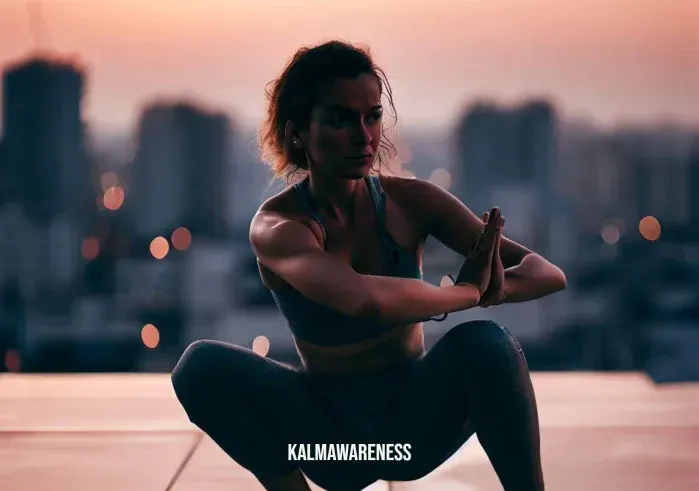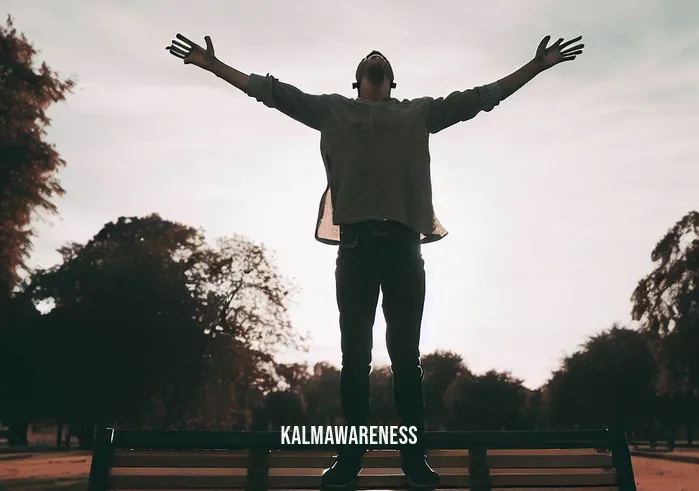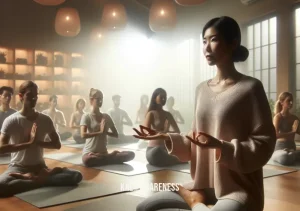Exploring the Squat Yoga Pose
In this article, we will delve into the intriguing world of the Squat Yoga Pose, a position that brings both challenge and balance to your yoga practice. Prepare to experience the benefits of this pose as we break down its description, explore its variations, and guide you through the step-by-step process to achieve it. So, let’s dive in and discover the wonders of the Squat Yoga Pose.
Pose Name | Squat Yoga Pose
Original Name | Malasana
Difficulty Level | Intermediate
Pose Category | Standing Poses
Exercise Duration | Approximately 30 seconds to 1 minute for beginners, and up to 3 minutes for advanced practitioners.
The Squat Yoga Pose, also known as Malasana, is a grounding asana that is deeply rooted in yoga traditions. It resembles the natural squatting position, allowing you to connect with the earth and open up your hips, groins, and lower back. This pose may appear simple, but its benefits and challenges are vast, making it an essential addition to your yoga routine.
*”Squat like it’s hot!” *
In the next part of this article, we will explore the historical significance of the Squat Yoga Pose, understand its connection to the ancient yoga teachings, and uncover its potential to enhance your overall well-being. Join us as we delve deeper into the magic of Malasana.
Continue to Part 2 here to dive deeper into the roots of the Squat Yoga Pose and discover its historical significance.
Unearthing the Roots of the Squat Yoga Pose
Welcome back to our exploration of the Squat Yoga Pose! In the previous section, we introduced you to the basics of this grounding asana. Now, let’s take a journey into its historical significance and discover its connection to the ancient yoga teachings.
Stay tuned to unravel the secrets behind this timeless pose. In Part 2, we will explore the origins of Malasana and its role in the traditional yoga practices. We will also highlight the mental and physical benefits it brings to your well-being.
Keep your curiosity flowing and continue to Part 2 here to unearth the roots of the Squat Yoga Pose.
Embracing the Benefits of the Squat Yoga Pose
Congratulations on reaching Part 3 of our exploration of the Squat Yoga Pose! In the previous section, we delved into the historical significance of Malasana. Now, let’s shift our focus to the incredible benefits it can bestow upon your mind and body.
Stay with us as we uncover the numerous advantages of practicing the Squat Yoga Pose. From increased flexibility and strength to improved digestion and grounding energy, this pose is a powerful tool for enhancing your overall well-being.
Get ready to embrace the goodness of Malasana in Part 3 here, where we highlight the transformative effects it brings to your life.

Embracing the Benefits of the Squat Yoga Pose
As we dive deeper into the world of the Squat Yoga Pose, it’s time to explore the myriad of benefits this grounding asana brings to your mind and body. Beyond its historical significance, Malasana holds transformational powers that can enhance your overall well-being in various ways.
The Wonderful Benefits of Squat Yoga Pose
- Hip and Groin Opening: Malasana is renowned for its ability to open up the hips and groin, releasing tension and promoting flexibility in this area. It can be particularly beneficial for individuals who spend long hours sitting or have tight hips.
- Lower Back Relief: By gently stretching the lower back muscles, Squat Yoga Pose can alleviate discomfort and promote a sense of relief, especially for those who experience mild lower back pain.
- Strengthens Lower Body: This asana engages the muscles in your thighs, calves, and ankles, which helps in building lower body strength and stability.
- Digestive Health: The squatting position aids in massaging and stimulating the digestive organs, potentially improving digestion and easing any digestive issues.
- Pelvic Floor Strengthening: As you hold the pose, you engage your pelvic floor muscles, promoting strength and stability in this crucial area.
- Grounding Energy: Malasana connects you to the earth, creating a sense of grounding and stability, which can be particularly beneficial during times of stress or anxiety.
- Mental Focus: Holding the pose requires concentration and focus, allowing you to achieve a state of meditation and mental clarity.
- Enhanced Circulation: The deep bend in Malasana encourages blood flow to the pelvic region, which can be beneficial for reproductive health.
Who Should Avoid Squat Yoga Pose?
While the Squat Yoga Pose offers numerous benefits, it may not be suitable for everyone. If you have any of the following conditions, it is best to avoid or modify the pose:
- Knee Issues: Individuals with knee injuries or chronic knee pain should exercise caution while practicing Malasana. Consider using props like a block or cushion to lessen the pressure on your knees.
- Ankle Injuries: If you have ankle issues or limited ankle mobility, consult a yoga instructor for modifications or alternative poses.
- Lower Back Problems: If you suffer from severe lower back pain or sciatica, it’s wise to avoid this pose or practice it under the guidance of a knowledgeable teacher.
- Balance Issues: If you struggle with balance, consider using the support of a wall or chair while attempting Malasana.
Variations for Different Levels of Experience
Yoga is an inclusive practice, and there are variations of the Squat Yoga Pose that cater to practitioners of all experience levels:
- Beginner Variation: For beginners or those with tight hips, placing a block or cushion under your heels can make the pose more accessible and comfortable.
- Intermediate Variation: As your flexibility improves, you can work towards bringing your heels to the ground while maintaining proper alignment.
- Advanced Variation: Advanced practitioners can explore the full expression of Malasana by attempting Crow Pose (Bakasana) from the squatting position.
Remember to approach these variations with patience and awareness of your body’s limits. Avoid pushing yourself too far and always listen to your body’s signals.

Unveiling the Spiritual Significance of the Squat Yoga Pose
As our journey into the world of the Squat Yoga Pose continues, we now delve into the historical roots and the spiritual significance that this grounding asana holds. Beyond its physical benefits, Malasana carries a profound connection to the ancient yogic traditions and offers a gateway to a deeper spiritual practice.
The History of Squat Yoga Pose
The origins of Malasana can be traced back to the ancient land of India, where yoga emerged as a way of life thousands of years ago. This traditional pose was adopted by yogis as a way to sit in a meditative posture for extended periods, aiding them in their journey towards self-realization and enlightenment.
Throughout the ages, the Squat Yoga Pose has remained a fundamental part of various yogic practices, symbolizing humility, patience, and the connection to the Earth and its energies. The name “Malasana” is derived from the Sanskrit words “mala” (garland) and “asana” (pose), representing the shape of a garland formed by the arms during the posture.
Embracing the Spiritual Essence
Beyond its physical benefits, Malasana invites practitioners to explore its spiritual essence. The grounded nature of the pose helps us connect with the present moment and find stability in the midst of life’s challenges. As you settle into the squat, you become more attuned to your breath and the flow of energy within your body.
The Squat Yoga Pose is often associated with the Muladhara (Root) Chakra, located at the base of the spine. This chakra governs our sense of stability, security, and connection to the Earth. Practicing Malasana can help activate and balance this vital energy center, promoting a sense of grounding and security in your life.
Tips for Getting the Most Out of the Pose
To fully experience the essence of the Squat Yoga Pose, consider the following tips:
- Breathe Mindfully: Focus on deep, steady breaths throughout the pose. Inhale to lengthen your spine, and exhale to soften into the squat.
- Maintain Alignment: Keep your feet parallel and your knees in line with your toes. Avoid letting your knees collapse inward.
- Engage the Core: Draw your navel gently towards your spine to support your lower back and enhance stability.
- Find Comfort: If your heels don’t comfortably reach the ground, use a prop like a block or cushion for support.
Common Mistakes to Avoid
As with any yoga pose, it’s crucial to be mindful of potential misalignments or errors to prevent injury and receive the full benefits of Malasana:
- Rounding the Back: Avoid rounding your back excessively; instead, aim to maintain a long, straight spine.
- Putting Strain on Knees: Be cautious not to place too much pressure on your knees. Adjust the depth of your squat to a comfortable level.
Modifications for Individuals with Injuries or Limited Flexibility
If you’re dealing with injuries or limited flexibility, you can still enjoy the benefits of Malasana with these modifications:
- Use a Supportive Surface: Sit on a folded blanket or yoga block to elevate your hips and reduce strain on your knees.
- Hold onto a Support: Use a wall or sturdy object to assist with balance and stability during the pose.
Complementary Poses
To enhance the effects of the Squat Yoga Pose, consider incorporating these complementary postures into your practice:
- Pigeon Pose (Eka Pada Rajakapotasana): This hip-opening pose complements Malasana by further stretching the hips and groins.
- Cobra Pose (Bhujangasana): Cobra Pose helps counterbalance the forward bend of Malasana, promoting a healthy backbend.





